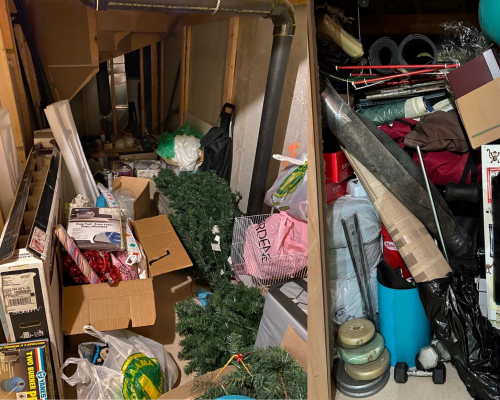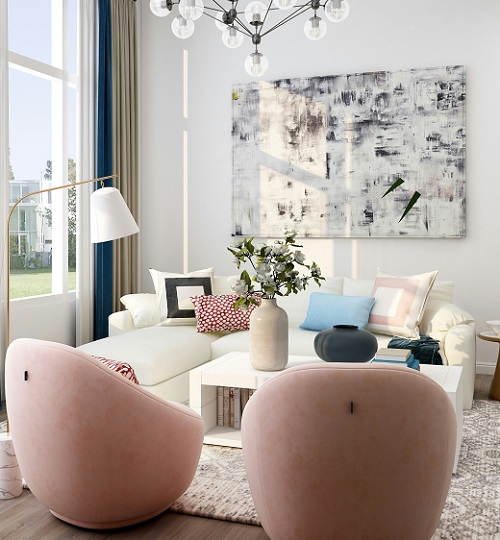Case Study: The Chaos of a Disorganized Home
By Pamela Wong
Pamela is a Trained Professional Organizer based in Oakville, Ontario and is the owner of Zen N Organized. She helps homeowners and small business owners transform their homes and home offices into organized spaces. She has a practical, non-judgemental approach to organizing. Her objective is to create functional and harmonious spaces for her clients.

Introduction: Living in a Constant State of Overwhelm
Meet Lisa, a 47-year-old marketing executive and mother of two teenage boys living in Toronto. She has a successful career, a loving family, and a beautiful home – but behind closed doors, her life feels anything but in control.
Her house is in a constant state of clutter: kitchen counters are buried in unopened mail and school forms, laundry piles in every bedroom, and her home office has become an unmanageable jungle of paperwork, chargers, and half-finished projects. Despite her best efforts, she can’t seem to keep up with the demands of her busy life.
Lisa’s situation is not unique. Many professional moms are being pulled in all directions -managing demanding careers, running households, supporting aging parents, and keeping up with their children’s activities. The lack of organization in their homes only adds to their stress, affecting their well-being and that of their families.
What It’s Like to Live in a Disorganized Home
At first glance, a bit of clutter may not seem like a big deal. However, Lisa has discovered, disorganization takes a toll on every aspect of life:
1. Increased Stress and Mental Overload
Lisa wakes up every morning feeling behind before the day has even begun. She wakes up amongst the physical clutter that instantly makes her anxious. Finding a missing bill or locating a lost pair of shoes turns into a frantic search that leaves her frustrated and irritable. Her mind never feels at ease because there’s always something that needs tidying up.
2. Strained Family Relationships
Family dinners often feel rushed and disconnected, with each family member distracted by the overwhelming mess around them. Conversations become tense, and Lisa and her husband find themselves bickering over chores and responsibilities. What should be a warm and inviting space has turned into a source of conflict.
3. Lower Productivity and Poor Time Management
Her “working from home” days are unproductive. Spending half of her time searching for important documents and dealing with distractions in a cluttered workspace tasks take longer than necessary. She often finds herself working late into the night, cutting into valuable family time.
4. Negative Impact on Physical Health
Disorganization leads to poor habits – Lisa often opts for takeout because her kitchen is too messy to cook in. Her sleep suffers because she lies awake thinking about everything she needs to do. Piles of laundry and clutter attract dust, triggering her allergies more than usual.
What Are the Causes of a Disorganized Home?
While Lisa wants a tidy home, several factors contribute to the ongoing mess:
1. Overcommitment and Lack of Time
Between work meetings, kids’ activities, and household chores, Lisa has no time left to organize. By the time she finishes her responsibilities for the day, she is too exhausted to tidy up.
2. Too Much Stuff
Lisa’s family has accumulated a lot over the years – from gifts, impulse purchases, hand-me-downs, to sentimental items. There’s simply not enough space to store everything, and items pile up in every corner.
3. Lack of a System
Lisa never established a structured system for organizing her home. Without clear places for mail, keys, or school paperwork, everything ends up wherever the item lands. This leads to frequent missing things and an overall sense of disorder.
4. Decision Fatigue
By the time Lisa finishes making decisions at work, she has little mental energy left to decide where things should go at home. Instead of decluttering, she procrastinates, and the mess continues to build.
Solutions: How Lisa Regained Control of Both Her Home and Life
Recognizing that her home environment was negatively impacting her well-being, Lisa took action. Here’s how she transformed her space and mindset:
1. Decluttering in Small Steps
Instead of attempting to tackle the entire house at once, Lisa dedicated 15 minutes a day to decluttering one small area. She started with her kitchen counter, sorting mail and getting rid of unnecessary papers. Breaking the task into smaller steps made it more manageable.
2. Implementing the ‘One In, One Out’ Rule
To prevent clutter from accumulating, Lisa adopted a simple rule: for every new item that entered her home, one old item had to go. This approach helped her family become more mindful of what they brought into the house.
3. Creating a Functional Home Organization System
Lisa set up a clear organization system:
- A designated basket for mail and paperwork
- Hooks by the entryway for keys and bags
- Storage bins labeled for different family members
- A “donation box” in the garage for items they no longer needed
4. Delegating and Involving the Family
Lisa stopped trying to do everything herself. She assigned age-appropriate tasks to her children (and her husband) and set up a weekly “family reset” where everyone spent 30 minutes tidying up. Her husband took charge of sorting the mail and paying bills, relieving some of her mental load.
5. Seeking Professional Help
Realizing she needed expert guidance; Lisa hired a professional organizer for a one-time home reset. The organizer helped her optimize her storage space and establish lasting habits for maintaining order.
6. Establishing Daily and Weekly Routines
Lisa implemented simple routines:
- A five-minute evening reset to clear common areas
- A Sunday planning session to review the upcoming week
- Meal prepping on weekends to avoid last-minute takeout.
These simple and manageable routines helped her maintain organization without feeling overwhelmed.
The Transformation: A Home That Brings Peace, Not Stress
A few months into her organizational journey, Lisa noticed a dramatic change:
- She felt calmer and more in control.
- Mornings were less stressful since everyone knew where things were.
- Family dinners became more enjoyable in a clutter-free dining space.
- She was more productive at work, leading to better work-life balance.
- She even had time to enjoy personal hobbies, like reading and yoga.
Final Thoughts: Your Home Should Work for You, Not Against You
Lisa’s story is proof that an organized home can lead to a happier, healthier life. If you’re a busy professional mom struggling with disorganization, know that change is possible. Start small, establish routines, involve your family, and don’t hesitate to seek help when needed. Your home should be a place of peace, not stress – take control and create a space that supports your well-being and success.
Are you ready to transform your home? Start today with one small step, and soon, you’ll feel the difference.



